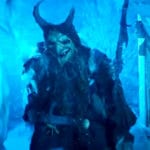 Mysteries
Mysteries  Mysteries
Mysteries  History
History 10 Surprising Stories About the Texas Rangers
 Humans
Humans 10 Philosophers Who Were Driven Mad by Their Own Theories
 Miscellaneous
Miscellaneous 10 Video-Game-Worthy Weapons and Armors from History
 Weird Stuff
Weird Stuff 10 Psychics Who Accurately Predicted Wartime Events
 The Arts
The Arts 10 Pieces of Art Inspired by a Broken Heart
 Health
Health 10 Science Fiction-Sounding New Medical Treatments
 History
History 10 Surprising Facts About the Father of Submarine Warfare
 Space
Space Ten Astonishing New Insights into Alien Worlds
 Weird Stuff
Weird Stuff 10 Bizarre Summer Solstice Rituals Still Practiced Today
 Mysteries
Mysteries Top 10 Haunting Facts About the Ghost Ship MV Alta
 History
History 10 Surprising Stories About the Texas Rangers
 Humans
Humans 10 Philosophers Who Were Driven Mad by Their Own Theories
Who's Behind Listverse?

Jamie Frater
Head Editor
Jamie founded Listverse due to an insatiable desire to share fascinating, obscure, and bizarre facts. He has been a guest speaker on numerous national radio and television stations and is a five time published author.
More About Us Miscellaneous
Miscellaneous 10 Video-Game-Worthy Weapons and Armors from History
 Weird Stuff
Weird Stuff 10 Psychics Who Accurately Predicted Wartime Events
 The Arts
The Arts 10 Pieces of Art Inspired by a Broken Heart
 Health
Health 10 Science Fiction-Sounding New Medical Treatments
 History
History 10 Surprising Facts About the Father of Submarine Warfare
 Space
Space Ten Astonishing New Insights into Alien Worlds
 Weird Stuff
Weird Stuff 10 Bizarre Summer Solstice Rituals Still Practiced Today
Top 10 Bizarre Facts About Popular Christmas Movies
Back in 1898, George Albert Smith created one of the first Christmas films on record. The simple black and white footage showed Santa coming down the chimney of a family home and delivering gifts to sleeping children. Clocking in at just over a minute in length, the silent picture shows just how radically the industry has changed.
The Christmas movie is now big business, with Hollywood releasing anything from blockbuster epics to telefilm feel goods. Every July, Christmas decorations begin taking over parts of British Columbia in Canada. Film crews swarm the area and begin making dozens of inexpensive festive-themed movies for the likes of Hallmark and Lifetime (Hallmark made two dozen of them in 2019 alone). Many of the major streaming sites, including Netflix, are also jumping on board.
With the Yuletide season upon us once again, and with so many people still in lockdown, there is plenty of time to catch up on some of the classics. So, without further ado, let’s take a look at just 10 intriguing Christmas movie facts.
10 Unconventional Christmas Traditions From Around The World
10 John Candy was Paid Peanuts for Home Alone
Home Alone was made on a shoestring budget of just $18 million. Warner Brothers was originally at the helm of the project, until production costs soared past the film’s initial $10 million budget. But Home Alone writer John Hughes predicted the studio would backslide on its commitments. He secretly arranged for an alternative backer, leaving a copy of the script at the headquarters of 20th Century Fox. “Basically a screenplay was left somewhere so someone could pick it up. It was clandestinely delivered,” explained producer Scott Rosenfelt. So when Warner scrapped production, Hughes and co. were ready to continue work under an entirely different studio.
Funding remained a major obstacle. The actor who played Marv (Daniel Stern) quit after he was asked to work an additional two weeks with no extra pay. After things didn’t work out with his replacement, the studio convinced Stern to come back. Meanwhile, John Candy was paid virtually nothing for his role as Gus Polinski – the lovable musician who reunites Kevin McCallister with his mother. Candy filmed his scenes in just a single day and received less pay than the actor who played the pizza delivery guy ($414). The film has since grossed nearly half a billion dollars.[1]
9 A Pregnancy Made Die Hard Possible
Bruce Willis wasn’t exactly the studio’s first choice to play John McClane. The studio, keen to get a tried and tested action star on board, first approached the likes of Sylvester Stallone and Harrison Ford. Even Clint Eastwood, who owned the rights to the film in the ‘80s, was considered for the part.[2] The studio had so little confidence in Willis’ ability to get eyeballs at the box office that it marketed the film posters with images of just the Nakatomi Plaza.
At the time, Willis was starring alongside Cybill Shepherd in the comedy TV show Moonlighting. Production of Die Hard conflicted with shooting for Moonlighting, meaning Willis was initially forced to reject the part. In 2013, the actor explained how everything changed: “Thank God Cybill Shepherd got pregnant. [Producer] Glenn Caron gave us off 11 weeks and I went to go do Die Hard.’”[3]
Willis went through a lot during his time as the rough and ready New York cop. He lost two-thirds of his hearing in one ear, after firing blank cartridges from a prop gun. On his first day of shooting, he performed an action stunt involving an explosion atop Nakatomi’s rooftop helipad (it was actually just a five-story garage). The production team used bags of gasoline to simulate the building exploding, smearing Willis in fire-retardant goo to protect him from the ensuing inferno. The force of the blast was so powerful that it almost threw the action star clear of the air bag: “I was like, ‘Why would you shoot this scene first?’ And they were like, ‘If you were killed at the end of the movie, it would cost us a lot more money to reshoot the whole thing with another actor.”
8 The Reason for It’s a Wonderful Life’s Meteoric Success
Frank Capra’s It’s a Wonderful Life is widely regarded as one of the best movies of all time. This was not always the case, however. The film received mixed reviews upon its release in December 1946 and initially failed to recoup its production costs. The film quickly disappeared from public consciousness, until many decades later.
It turns out that films shot before 1968 are subject to the U.S. Copyright Act of 1909.[4] Any movie that falls under the act is automatically awarded a 28-year copyright term. A second 28-year term then comes into force, but only if the copyright holder applies for it. In this case, Republic Pictures failed to fill out the necessary paperwork and lost its rights to the film. The embarrassing blunder meant It’s a Wonderful Life entered the public domain in 1978, prompting television networks to broadcast the film during the holidays. After several decades of royalty-free broadcasts, the movie became synonymous with Christmas.
In 1993, Republic Pictures took the matter to the Supreme Court. The studio argued that it retained copyright privileges, because it owned the rights to the story the movie was based on (The Greatest Gift).[5] After winning the case, Republic gave NBC exclusive rights to show the film on its network.
7 The Grinch that Caused Mental Health Problems
The Grinch was a grueling experience for everyone involved. It took over eight hours to apply the makeup for Jim Carrey’s first shoot. Carrey was far from amused. He returned to his trailer and, in a fit of anger, put his foot through the wall. The studio took unusual measures, arranging for Carrey to meet with someone who specialized in teaching CIA operatives how to endure torture. All in all, Carrey was forced to don the Grinch suit 100 times.
This grueling process also took its toll on the film star’s makeup artist, Kazuhiro Tsuji. In 2017, Kazuhiro told the press that production of the film was delayed because of Carrey’s many meltdowns, with the actor often going missing for long periods. While the atmosphere on set eventually improved, the makeup artist later admitted that he needed therapy sessions after working with Carrey.[6]
6 Bill Murray Suffered on the Set of Scrooged
In 1988, Bill Murray delighted audiences with his comedy take on A Christmas Carol, Scrooged. The film sees Murray play the part of Frank Cross, a big shot TV executive who becomes obsessed with getting the best network ratings. Like Dickens’ Ebenezer Scrooge, Cross is visited by three ghosts who remind him of the importance of friendship and family during Christmas. Several scenes involve the Ghost of Christmas Present (Carol Kane), an abusive fairy who constantly beats, slaps, and pinches Frank into submission. Much of this slapstick comedy, it turns out, was very real.
Bill Murray made the mistake of telling Kane to make the scenes look as authentic as possible. “There’s a piece of skin that connects your lip with your gums and it was really pulled away,” Murray recalls. “She really hurt me.” Shooting was temporarily suspended to allow the actor’s lip to heal itself. One of Murray’s brothers, who also starred in the film, found the scenes particularly enjoyable: “[I]t was fun watching Carol Kane almost take his nose off with a toaster repeatedly.”[7]
The scenes affected Kane emotionally. In an interview with the now-defunct sci-fi magazine Starlog, Murray and film director Richard Donner described how the actress would break down in tears for 20 minutes at a time.[8]
10 Weird British Christmas Traditions
5 Why Elf 2 Never Happened
Elf was a career first for Will Ferrell, representing his first lead role in a major movie. The film received critical acclaim and went on to gross a staggering $220 million. So it came as quite the surprise to learn that a sequel was no longer in the works. Officially, Farrell says he declined the role because he did not want to play “Buddy the middle-aged elf.” [9]
Actor James Caan, who played Buddy’s father, has a somewhat different take on why Elf 2 never happened. “The director [Jon Favreau] and Will didn’t get along very well. Will wanted to do it, and he didn’t want the director. He had it in his contract. It was one of those things.”[10]
The studio offered the Anchorman star $29 million to put the green tights back on, but Ferrell declined. In an interview in 2006, the comedy legend said he couldn’t stomach the idea of making a subpar sequel for a quick buck.[11]
4 The Nightmare Before Christmas was Painstaking
The Nightmare Before Christmas used stop-motion animation to bring Jack Skellington and his spooky sidekicks to life. As the Tim Burton epic was shot in 24 frames per second, animators would need to move each of the characters in a scene 24 times for each second of usable footage. With just one minute of footage taking up to a week to shoot, it’s no wonder the film took three years to finish.[12]
At the start of production, a team of sculptors set about crafting hundreds of puppets. Movable skeletons were embedded in each character mold, allowing animators to move them on the fly. Many of the facial expressions were achieved by switching between different model heads. Jack Skellington, for example, had around 400 heads.
The studio constructed hundreds of model sets across 19 sound stages. A series of trap doors were then carved into each set, providing enough space for film workers to reposition their characters. This process was not without its difficulties, though. A single mistake in the lighting or camera work would cost the team hours of work. “If you have a problem with a frame, you have to re-photograph the entire thing,” explained the supervising animator, Eric Leighton.
3 The White Christmas Ending was Reshot for Royalty
The 1950s was the Golden Age of Television, with TV sets starting to appear in living rooms across America. The shift sparked panic among movie executives, who noticed that many of their high-profile stars were shifting to television. In a bid to keep audiences coming back to the movie theater, new technologies were starting to gain traction. Released in 1954, White Christmas was lauded for introducing cinema-goers to VistaVision, a new printing process that provided deeper colors and a sharper widescreen picture.[13] It worked. The Christmas flick was a storm at the box office, raking in over $12 million and generating rave reviews.
White Christmas tells the tale of a couple of movie producers, played by Bing Crosby and Danny Kaye, who try to save their former army buddy’s inn from financial ruin. The two put on a stage show at the establishment and invite their brothers in arms to attend. The final scene sees Crosby and Kaye close out the show with an iconic rendition of White Christmas.
Rosemary Clooney (George Clooney’s aunt) played Crosby’s love interest. She recalls how the cast and crew had just finished wrapping up the film’s musical finale when the director, Michael Curtiz, asked them to re-do the entire scene. The director thought the pretend reshoot would impress a couple of very special visitors: the king and queen of Greece. But Crosby wasn’t a fan of the idea.
“Michael Curtiz said, ‘now the king and queen of Greece are coming to visit the set, and I want to pretend that we’re shooting this over again,’” explained Clooney. “And I hear Bing [whispering], ‘Not me.’ And so I say, ‘Where are you gonna go?’ And he says, ‘Golf.’”[14]
2 Love Actually’s Missing Story Thread
Love Actually follows a group of ordinary people as they gear up for the Christmas holidays. The film’s interweaving story became a huge box office success following its 2003 release, with the film earning a healthy $250 million. But it turns out that one major story arc was left on the cutting room floor.
The film’s writer and director, Richard Curtis, came up with a tragic story about a lesbian headmistress who loses her partner to cancer. The audience is first introduced to the headmistress as she rebukes a student for coming up with a bizarre Christmas wish – the ability to see a person’s farts. But we soon learn there is a reason for her sense of humor failure. After school finishes, she returns home and cooks for her bedridden partner, Geraldine. As the scene unfolds, we soon discover that Geraldine is terminally ill.
“I was really sorry to lose this,” said Curtis.[15] The famed comedy writer explained that the couple’s story was cut because one of the scenes no longer made sense after the edit. He also touched upon the abruptness of Geraldine’s death, which receives only a passing reference before the film’s finale.
1 TV Execs Weren’t Keen on A Charlie Brown Christmas
A Charlie Brown Christmas defied expectations upon its release in 1965, with nearly half of the TV-owning public tuning in to watch the cartoon. Today, the holiday special is a staple of the American Christmas. But in the run-up to the broadcast, TV executives were not convinced of its potential. Charlie Brown talks about how Christmas is making him depressed, while other characters complain about the festive season’s commercialization. The network bosses were critical, claiming the work was “better suited to the comic page.”[16] CBS only decided to run the special because it was already listed in the TV guide.
The creators were also conflicted. The animation director, Bill Melendez, thought the religious-themed ending was too “dangerous.” A despondent Charlie Brown asks, “Isn’t there anyone who knows what Christmas is all about?” Linus responds with a perfect recital of the Gospel of Luke, taking center stage to recount the birth of Jesus Christ.
It was Charles Schulz, the creator of the Peanut gang, who pushed for the inclusion of the Biblical verses. Having converted to Christianity shortly after his experience of World War II, much of Schulz’s work was heavily influenced by religion.[17] Melendez remained nervous about Linus’ monologue, as most television shows avoided religious themes. Schulz told Melendez, “Bill, if we don’t do it, who else can?” The gamble paid off, and A Charlie Brown Christmas looks set to celebrate its 55th anniversary.
Top 10 Christmas Songs Dark Enough To Ruin Your Christmas Spirit








